By Marina Estarque and Silvia Higuera
Latin America is the most dangerous region in the world for women, with high rates of femicide that continue to increase, according to the United Nations. In 2018, more than 3,500 women were murdered in 25 countries in the region for gender reasons, according to a report by the Economic Commission for Latin America and the Caribbean (CEPAL in Spanish).
In September, two podcasts that addressed femicide in two countries in Latin America were released. The latest episodes, including extras, aired in November. The narrative journalism podcasts Praia dos Ossos and The Red Note start with crimes committed decades ago, to address a reality that persists in the region: systemic violence against women and a macho culture that blames the victims and doesn’t punish the murderers.
The LatAm Journalism Review (LJR) spoke to the creators of both podcasts, whose mission is not discovering the perpetrator of the crimes or unraveling a mystery, but rather explaining the cultural roots and the flaws in the justice system that allow these crimes to perpetuate.
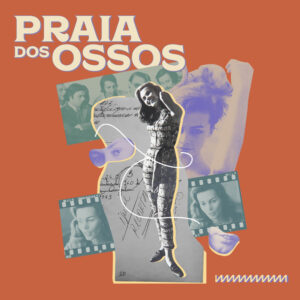
Collage for Praia dos Ossos. Image: Courtesy/Rádio Novelo
Praia dos Ossos
The narrative journalism podcast Praia dos Ossos, created by Rádio Novelo, tells the story of a wealthy housewife, Ângela Diniz. In 1976, Diniz was murdered with four shots by the then boyfriend Doca Street, at a house in Praia dos Ossos, in Buzios, in the state of Rio de Janeiro. The case was known by the name of the murderer, the confessed defendant Raul Fernando do Amaral Street, also known as “Doca” — which in itself reveals an injustice, because it erases the victim's name and history.
In the years following the crime, a narrative created by Doca's defense lawyers and taken over by much of the press and public opinion at the time, turned the murderer into a victim and, finally, a hero. The podcast says that T-shirts with his face appeared, and a restaurant started serving “Doca Street steak” and even made a drink in his honor, which came with four candies in the glass. In 1979, during his first trial, Doca was greeted by a legion of fans outside the courthouse.
Defense lawyers argued that Diniz had offended Doca’s “man’s honor,” which forced him to kill her. The thesis, which was known as “legitimate defense of honor,” was successful. At the trial, Ângela's reputation was attacked. Diniz was called "Babylonian high-end prostitute," "libertine," "depraved," among other names.
Doca was sentenced to two years in prison but left the court free because he had already served part of the sentence. The decision generated outrage among women and boosted the feminist movement in Brazil. In the 1980s, during the second trial, feminists were mobilized, and Doca was sentenced to 15 years in prison, of which he served three years.
The founder of Rádio Novelo, Branca Vianna, presenter and creator of Praia dos Ossos, says the idea of creating the podcast came from the fact that newer generations did not know anything about the case. But Vianna did not want to follow the true crime style, a genre of podcast that is very successful and has as a great example the North American podcast “Serial.”
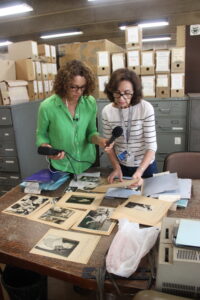
Founder of Rádio Novelo, Branca Vianna, during research in newspaper Estado de Minas. Foto: Divulgação/Rádio Novelo
Vianna says she doesn't like this genre. "We are not interested in dealing with crime, especially femicide, going into the sordid details of the story," she said in an interview with LJR. When asked about Serial, which also portrays a femicide, Vianna says she has an enormous professional admiration for the podcast and for its technical and narrative quality.
"That [Serial] is extremely well done, it is a lesson on how to make a podcast. [...] But I was very uncomfortable when I heard it and I thought I was complicit in what was happening —an exploitation of a femicide, in which the victim does not appear. Her corpse ‘appears,’ and so do the circumstances of her death, autopsy, but we don't know who that girl is, like she doesn't matter," she explained.
Vianna said she believes that Serial fails to present the social conditions that are the basis of gender violence. "What they do is turn it into a thriller. But it is a real story, so there are ethical issues that I think are very serious."
The researcher and production coordinator of the podcast, Flora Thomson-DeVeaux, says that, from the beginning, there was a concern about not turning crime into a spectacle. For her, this approach would be not only "morally disgusting," but redundant, because the "spectacular angle has been present since the beginning" of the coverage of the case. "This has been explored widely over the years," she told LJR.
In addition, the creators of the podcast argue that Diniz’s case would not lend itself to a true crime narrative because there is no mystery to be solved. Everyone knows how, when, where and who killed her. "It was very clear from the beginning that we were not going to dedicate time and space to these morbid minutiae that are the center of many productions of this type, like where the blood fell and things like that. That would have relevance if there were any doubts about who commited the crime, but since the circumstances were not a mystery, this didn’t make sense," Thomson-DeVeaux said.
Therefore, the team reflected on the importance of including every detail about the crime and decided that nothing would be included if it didn't have a clear function. "This is already something that we give a lot of thought to in a podcast script, because what is excessive overcrowds the script. It has to be a lean script, because the ear doesn't know how to digest a lot [of information]. What remains in the script you have to justify very well," Thomson-DeVeaux said. She added that, in the process of rigorously filtering the information, she thought about the victim's family and how they suffered from the media's exploitation of the case.
Having a critical opinion of true crime, Vianna and Thomson-DeVeaux decided that Praia dos Ossos would have a different focus. The goal would not be to narrate the crime itself, but to analyze the roots and repercussions. "For me, it only matters [if the crime] reveals something about the society in which we live and can point the right way," Vianna said, adding that the case was a "reflection of the society of the time."

Researcher and production coordinator of Praia dos Ossos, Flora Thomson-DeVeaux. Photo: Courtesy/Rádio Novelo
The podcast gives an in-depth account of the impacts of crime on the feminist movement, the role of sexist press coverage and the main flaws in the judicial system. It also assesses what has changed and what still needs to change.
The fact that it is an old crime allowed an analytical distance, according to Vianna and Thomson-DeVeaux. "People keep picking up recent cases from the news telling us to do Praia dos Ossos 2, and it doesn't make sense. Because our proposal has always been to take this case that had an evident importance at that time, but also had repercussions for decades,” Thomson-DeVeaux said, making it clear that there are no plans for a second season of the podcast.
Praia dos Ossos also differentiates itself from true crime podcasts in its research and investigation efforts to tell the victim's story and reveal their voice. In one of the strongest moments of the podcast, they manage to find a rare record of the voice of Ângela Diniz, in a credit card commercial, and admit to being "absolutely obsessed" with the audio recording.
Thomson-DeVeaux says she sought to escape the war of narratives that took place after the crime, when there were groups that tried to sanctify or demonize Diniz. "There is a kind of automatic reaction to idealize the victim, and that is also not interesting. Ângela was a complex character. We started essentially out of a curiosity, to understand who she was."
To find these records, Thomson-DeVeaux researched newspapers and magazines from that time, mainly in the National Digital Library. When some article was not in the digital collection, she and Vianna went looking for a print version in "sebos" (bookstores that sell used books and newspapers), on the book site Estante Virtual and in a newsstand that sells old magazines in Rio de Janeiro. The two say they "plucked" and "attacked all the 'sebos' out there."
Thomson-DeVeaux said she was "addicted" to the research and read "hundreds of thousands of texts" in a type of work that she describes as "pure accumulation" and "persistence." "The best things came out of that work. It's a bit of manual work and panning. You read 15 stories that don't say anything new and on the sixteenth you find some bizarre detail, some quotation marks, that ‘gives you gas’ to read 30 more," Thomson-DeVeaux remembered.
They also went to Minas Gerais, home state of Ângela Diniz, and visited the state library, where they found local publications that were not in the National Library. Unlike digital collections, where it is possible to search for keywords, they had to read entire newspapers to look for a single story.
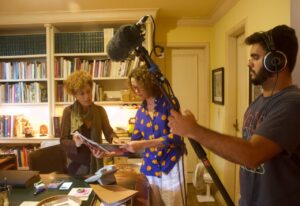
Founder of Rádio Novelo, Branca Vianna, in an interview for Praia dos Ossos. Photo: Courtesy/Rádio Novelo
The podcast creators asked the librarian for all material from a certain year, which was important for the story, and hoped to find some information there. "You put on a glove and start looking ... I would ask [for materials], and the girl would put those gigantic volumes totally dusty in front of me," Vianna recalled.
Although it takes time, this type of research has its advantages. As it was necessary to look page by page, the researchers ended up learning about the context of that time, Vianna said. "You can see what kind of advertising there is in the magazine, how the women were portrayed, what were the other things that were happening in that city that year. And that helps you to better understand the subject you are actually researching. It’s a very cool in person process, because it keeps giving you ideas."
Praia dos Ossos took almost two years to complete. There were more than 50 interviews, 80 hours of recorded material, and a team of more than 40 people, with the creative direction of Paula Scarpin, also from Rádio Novelo. The rights were purchased by Consórcio Filmes, which will adapt the story for the audiovisual.
La Nota Roja
In 1993, the world began to know Ciudad Juárez, in Mexico, due to the growing number of femicides. The city had become one of the most dangerous places in the world and some media referred to Ciudad Juárez as "the city that kills women".
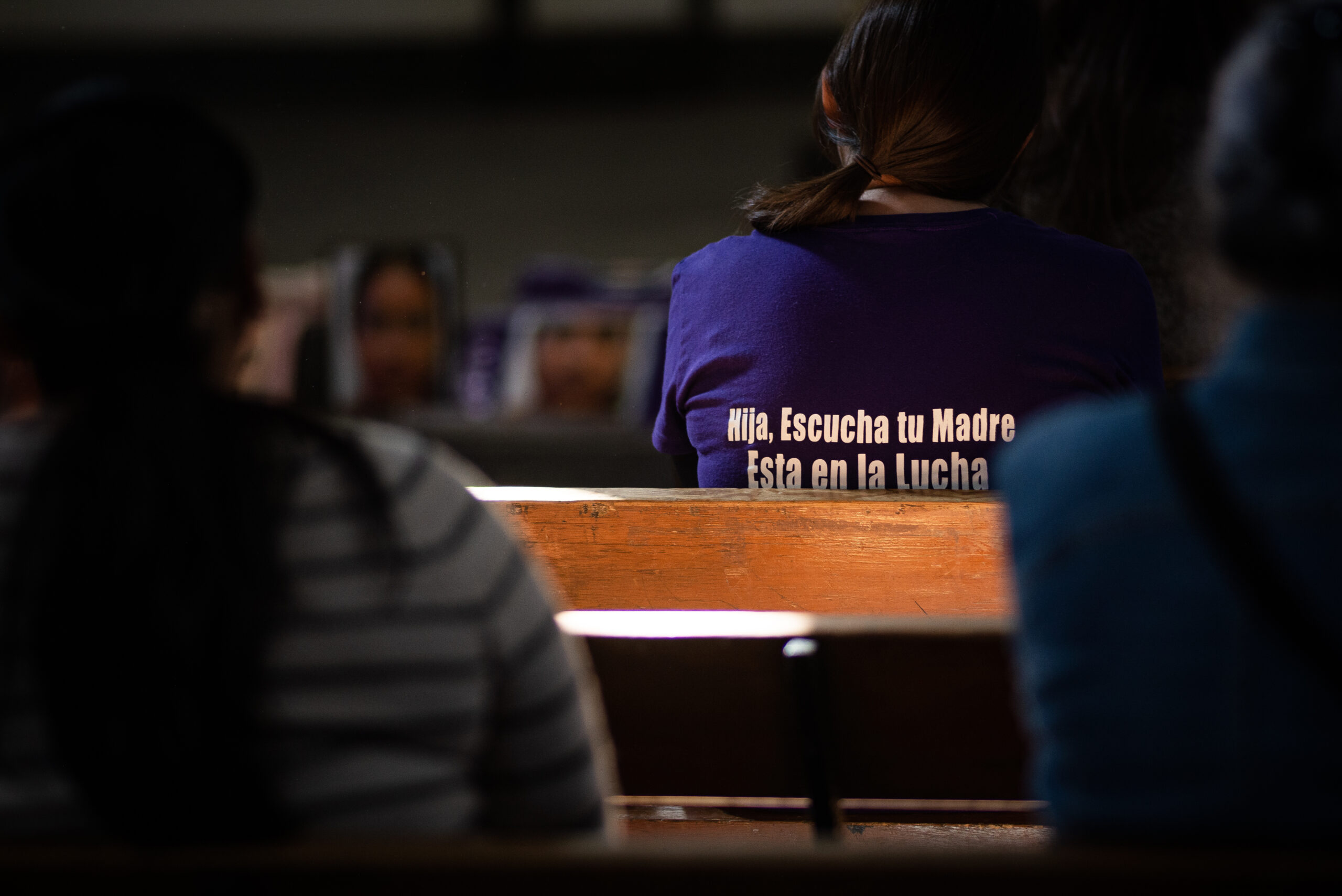
Mother of a feticide victim in Ciudad Juárez. (Photo: Abraham Buendía Rodríguez /Courtesy Imperative Entertainment & Blue Guitar)
Women and young girls disappeared and were found dead, with signs of sexual abuse and a brutal death. Between 1993 and 1999, 198 murders were committed in Ciudad Juárez, according to official records. More than 25 years later, violent crimes have not stopped and the majority remains unpunished.
In an effort to give visibility to these cases, The Red Note was created. The Red Note is a podcast available in English and Spanish (La Nota Roja) that addresses femicides in Ciudad Juárez through testimonies from family members of victims, researchers, academics, journalists and activists.
Before The Red Note was created, director Craig Whitney and producer Estefanía Bonilla Hernández wanted to make a feature film. However, during the search for funding, Imperative Entertainment suggested they make a podcast as well.
"It was very interesting because a feature film is only a few hundred minutes long, and this story is much more complex than what we can tell in a feature film," Whitney told LJR. “The podcast explores the causes, the different perspectives, and the evolution of this story during the 25 plus years of femicides in Juárez."
The podcast, whose last chapter was published on November 17, began years before its recording and production that took place during 2020, Whitney explained. Whitney and Bonilla Hernández have been investigating femicides for almost 10 years and therefore knew that all information should be treated with care —starting with the use of appropriate language to how to approach the victims' families.
“I think it's important that we can share the culture of the border, the personality of the people of Juárez and Chihuahua,” Whitney explained. “But at the same time, the story of femicides in Juárez is the story of the beginning of the femicide crisis in Mexico. And to understand this problem, it is important that we understand where the crisis begins and why it starts in Ciudad Juárez."
From the beginning, they wanted to include journalists who had investigated the subject and who knew how to explain it in their team — made up of almost 30 people. That's how journalists Alicia Fernández and Lydia Cacho became part of the project. Fernández is from Ciudad Juárez and has covered violence in the region, including femicides, for media outlets such as El Diario de Juárez, El País, and now as a freelancer. She was in charge of reporting and interviewing for the podcast, as well as checking parts of the script.
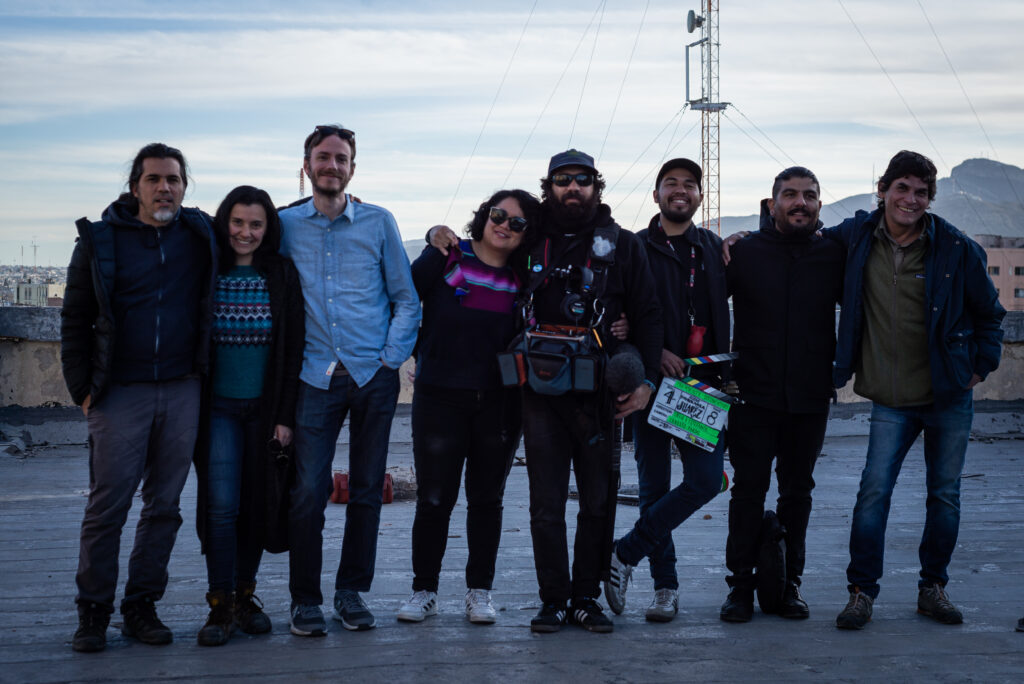
Equipo del podcast La Nota Roja: Ernesto Pardo, Estefanía Bonilla Hernández, Craig Whitney, Alicia Fernández, Nicolás Aguilar Limenes, Rafael Hernández, Renix Nava y Héctor Zubieta. (Foto: Abraham Buendía Rodríguez / Cortesía Imperative Entertainment & Blue Guitar)
"We are very lucky to be able to work with Alicia on this project," Whitney said. “It is very difficult [a subject] and you have to be very careful during an interview with the relatives of the victims in Juárez. As a woman from the border, it was much easier not only to create a connection and do productive interviews, but also to do interviews carefully while respecting the emotions of the families."
According to Fernández, The Red Note is important in terms of retelling this story, which has been forgotten by the international press due to the extreme violence that Ciudad Juárez is experiencing. "The story, that was still developing and that had no solution, involving femicides and gender violence in the city, was left out," Fernández told LJR. "The motivations were precisely to collaborate on a project that, in my opinion, could make this contextual and that [...] allowed us to show a situation that has been going on for several years until today."
Cacho is the voice of both versions of the podcast. Her experience covering femicides in the 1990s and her work as an investigative journalist for human rights violations were vital to the project, according to Whitney.
“During the process of editing the script, I worked with Lydia during the editing process and used her perspective,” the director explained. "But, more than the information or the stories in the scripts, Lydia's passion for telling the story [was crucial]."
The entire production took about nine months. Three weeks of the nine-month production were spent in Ciudad Juárez, recording and refining the podcast. The team’s expertise allowed them to work faster, otherwise "we could not investigate femicides in Juárez in just nine months," Whitney said.
Since the first chapter, which aired on Sept. 22, the podcast has been heard in 23 countries, including Mexico and the United States, Europe and Asia. Having the podcast in English made it possible to reach a more international audience.
"I am very happy to be able to share the story not only in the United States or Mexico, but also with people from Egypt, Japan, Russia," Whitney said. “It was very important during the process of recording, writing and editing the podcast to combine my perspective as a 'gringo,' Alicia’s perspective as someone from the border and Lydia’s as a Mexican, because we are talking to many different people at the same time.”
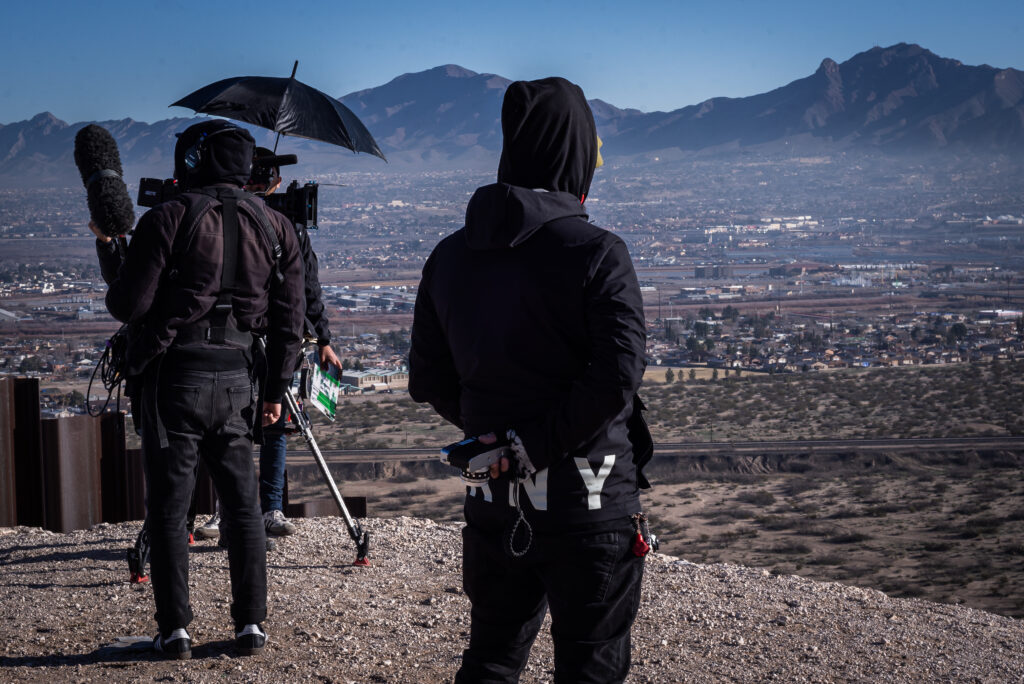
Equipo de La Nota Roja haciendo reportería en Ciudad Juárez. (Foto: Abraham Buendía Rodríguez / Cortesía Imperative Entertainment & Blue Guitar)
The podcast also had an impact on the press. The production appeared in various media outlets and also spurred interest from journalists who want to learn how to cover femicide.
"The podcast is a story of gender violence, but at the same time it is a story of the work of journalists like Alicia, like Blanca Carmona, like Lydia," Whitney said. "And it's a podcast about the work of Juárez collectives and activists without whom this story could have been overlooked by the public."
Fernández agrees that the podcast can impact the coverage of gender violence in the country and in the region. She said Whitney’s and Bonilla’s work has always been very careful and thoughtful regarding the use of language — something that gave her confidence to continue participating in the project. Fernández knows the subject well because she gives workshops on how to cover gender-based violence and the consequences that stereotyped coverage can have.
“There is a big responsibility in the way you say things. There is no [gender perspective] in institutions, it does not exist in language, it probably does not exist in many areas of journalism, so it is important to start paying attention to how these stories are told with a gender perspective [...] For me this is very important, because I know many mothers [of victims] who are a little tired of it," Fernández said.
The analysis of cases that occurred more than 25 years ago allowed them to find other perspectives, but at the same time it brought some disillusionment, because they found that the changes in terms of impunity were not significant. However, they recognize that it is important for other generations to know what happened in the city. “Doing this retrospective allows you to say ‘Look, I’m going to tell you a story, it happened 25 years ago, you probably weren’t born yet […] But maybe it will interest you,’” Fernández said.
Whitney adds that, in this case, it was not so relevant to discover the authors of the crimes, but the reasons behind them. “In this story it was more important to understand the problem in a systemic way, due to the combination of Juárez's ‘maquiladoras’, human trafficking, drug trafficking, weapons, corruption, Juárez's infrastructure ... all these combined forces cause femicides. Who the man with the gun is is less important than what is causing this gender violence on the border."
In addition to the podcast, the team worked in parallel to develop the feature film. The pandemic delayed the launch, but they hope to be able to release it in 2021, just as they plan to create another podcast season that can address gender-based violence in Mexico.